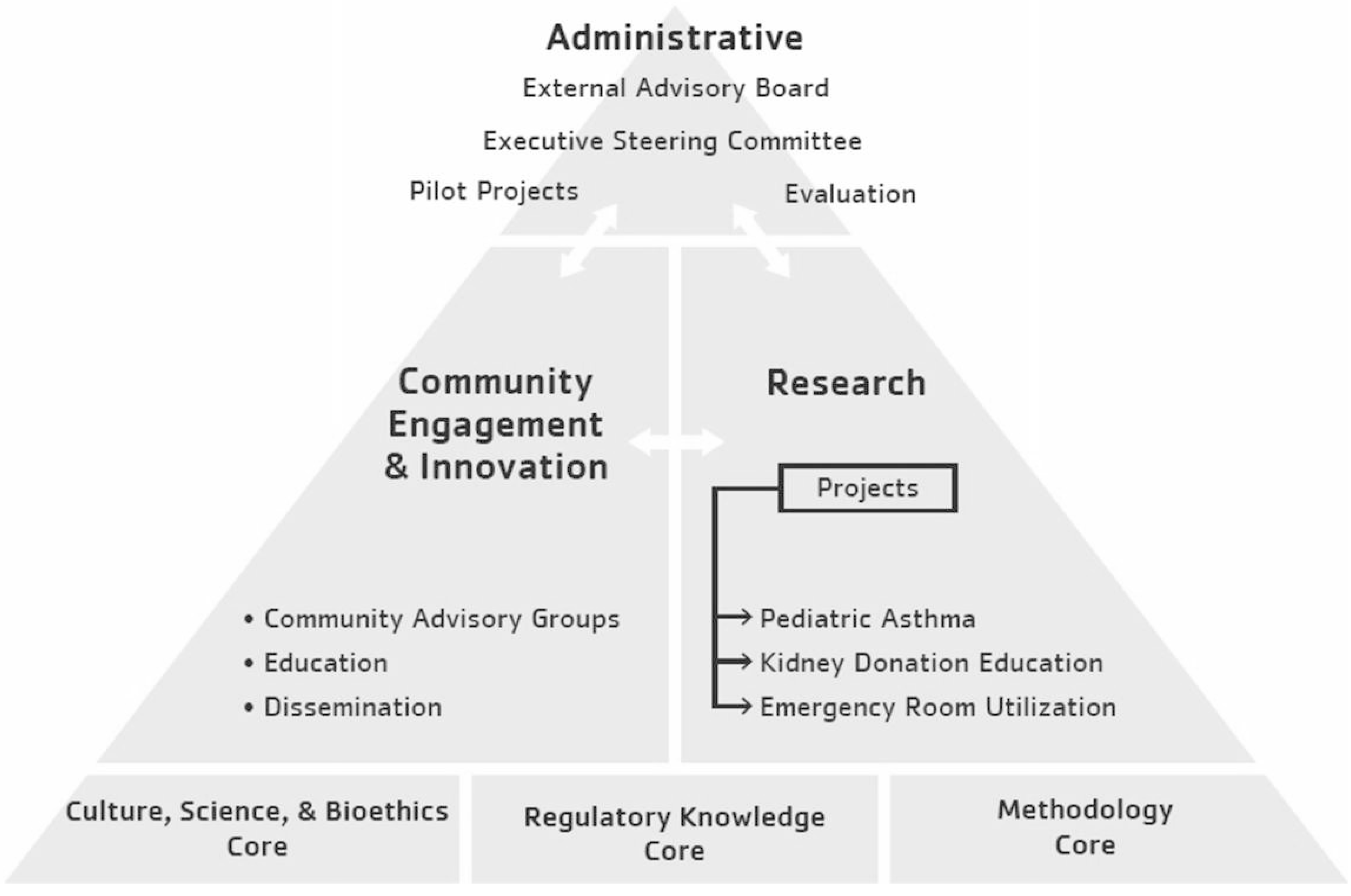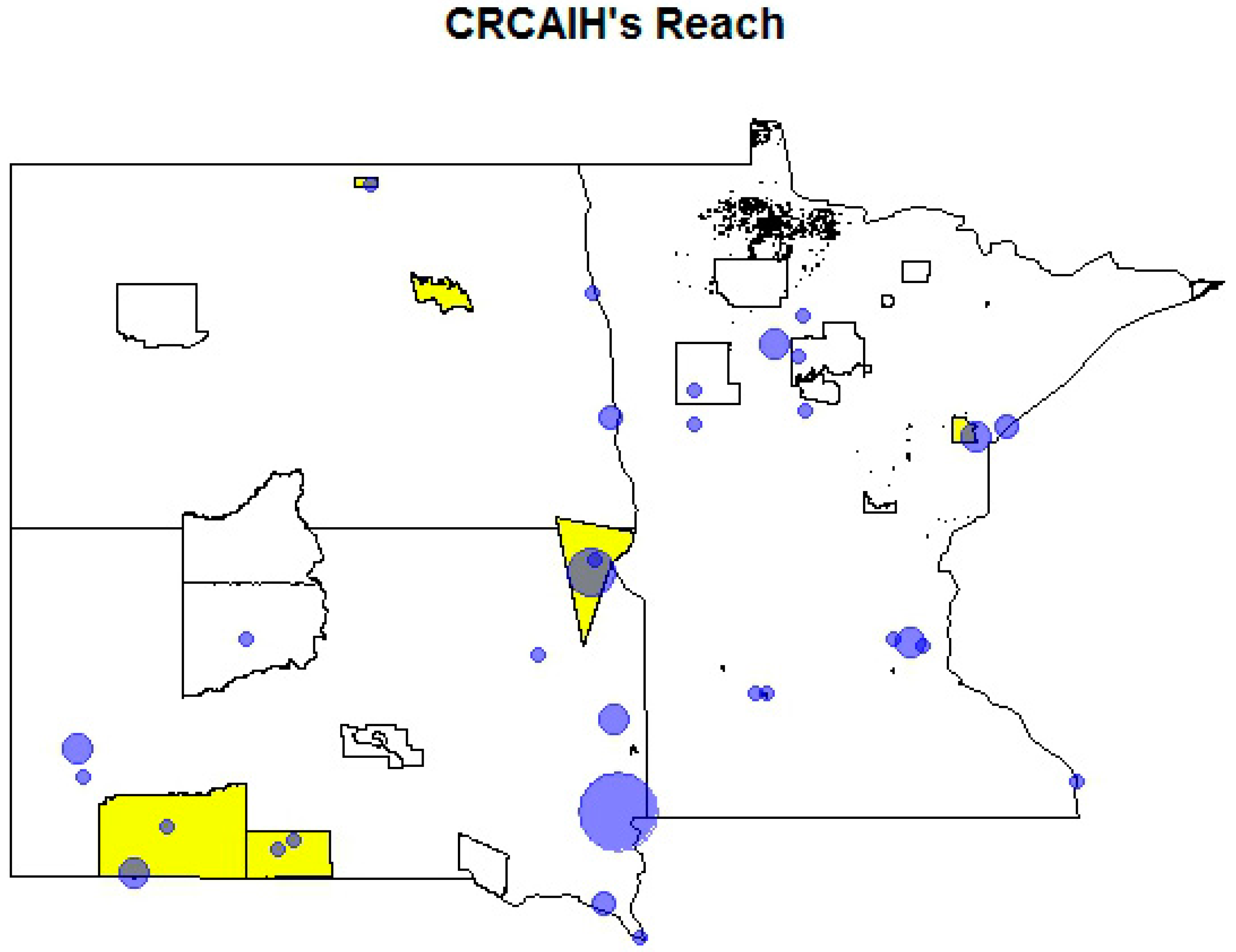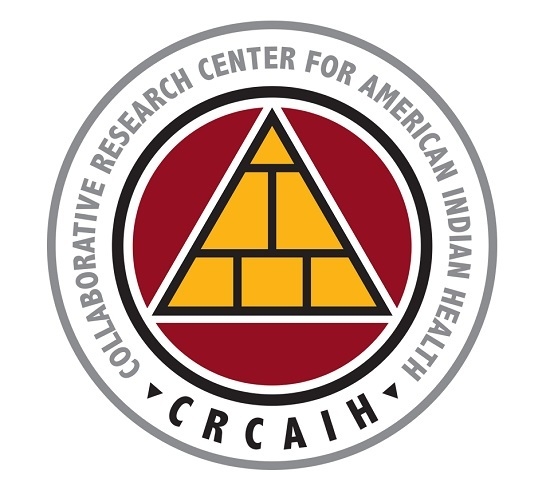Fostering Social Determinants of Health Transdisciplinary Research: The Collaborative Research Center for American Indian Health
Abstract
:1. Introduction
| Health Outcome | US General Population | Overall NHW | Overall AI/AN | SD Overall | SD NHW | SD AI/AN |
|---|---|---|---|---|---|---|
| Infant Mortality—2013 (rate per 1000 live births) [11] | 6.01 | 5.06 | 8.07 | 6.96 | 5.70 | 11.47 |
| Cancer—2012 (rate per 100,00) [12] | 432.3 | 432.2 1 | 262.3 | 426.6 | 427.2 1 | 469.8 |
| Diabetes—2012 2 (%) [10] | 9.2% | 7.9% | 17.9% | N/A | N/A | N/A |
| Heart Disease Mortality 2011–2013 (rate per 100,00) [13] | 171.6 | 173.9 | 157.2 | 153.1 | 150.1 | 218.4 |
| Heart Disease Incidence—2012 2 (%) [10] | 10.8 | 10.9 | 12.5 | N/A | N/A | N/A |

2. Collaborative Research Center for American Indian Health
| Tribal Nations and American Indian/Alaska Native Organizations | Research Institutions | Health-Care Organizations |
|---|---|---|
| Cankdeska Cikana Community College/Spirit Lake Nation | Sanford Research | Sanford Health |
| Fond du Lac Band of Lake Superior Chippewa | North Dakota State University | Children’s Hospitals and Clinics of Minnesota |
| Missouri Breaks, Inc. | South Dakota State University | Rapid City Regional Health |
| Oglala Sioux Tribe | University of North Dakota | |
| Rosebud Sioux Tribe | University of South Dakota | |
| Sisseton Wahpeton Oyate | ||
| Turtle Mountain Band of Chippewa Indians/Tribal Nations Research Group |
2.1. Historical Background of CRCAIH
2.2. Aims of CRCAIH
2.3. CRCAIH Divisions and Core Resources
2.3.1. Tribal Partner Selection
2.3.2. Pilot Grants Program (PGP)
2.3.3. Annual Summit
| 2013 | 2014 | 2015 | ||||||||
|---|---|---|---|---|---|---|---|---|---|---|
| Tribe | Tribe A * | Tribe B * | Tribe C | Tribe D * | Tribe E | Tribe F * | Tribe G | Tribe H * | Tribe I | Overall Average |
| Criteria | ||||||||||
| Location (possible 10 points) | 7 | 8 | 3 | 9 | 6 | 9 | 4 | 8 | 7 | 7 |
| Leadership Support (possible 30 points) | 24 | 28 | 9 | 27 | 19 | 26 | 16 | 27 | 18 | 22 |
| Community Support (possible 30 points) | 23 | 27 | 9 | 21 | 17 | 10 | 14 | 20 | 16 | 17 |
| Capacity/Infrastructure (possible 30 points) | 21 | 28 | 8 | 24 | 10 | 26 | 15 | 19 | 14 | 18 |
| Additional Considerations (possible 10 points) | 7 | 9 | 4 | 7 | 7 | 2 | 2 | 0 | 0 | 4 |
| TOTAL | 82 | 100 | 37 | 89 | 55 | 90 | 50 | 74 | 55 | 70 |
| Principal Investigator | Institution | Project Title |
|---|---|---|
| Year 1 | ||
| John Gonzalez, PhD | University of Minnesota Medical School, Duluth | Is my healthcare making me sick? Microaggressions in American Indian healthcare |
| Jessica D. Hanson, PhD | Sanford Research | Reliability and validity in a prevention program for American Indian women |
| Alicia Mousseau, PhD | Little Wound School, Oglala Sioux Tribe | Using mindfulness to reduce risky behaviors among American Indian youth |
| Soonhee Roh, PhD | University of South Dakota | Determinants of care and life quality in American Indian women with cervical cancer |
| H. Bruce Vogt, MD, FAAP and Jay Memmott, PhD, MSW | University of South Dakota | Assessing the impact of lay patient advocate training in tribal communities |
| Year 2 | ||
| Emily Griese, PhD | Sanford Research | Impact of residential treatment on American Indian maternal-child health outcomes |
| MaryLou Mylant, PhD | South Dakota State University | American Indian pilot study on caregiving attachment and health of young children |
| Daniel Petereit, M.D | Rapid City Regional Hospital | Walking forward American Indian survivorship physical activity pilot |
| Heather Peters, PhD | University of Minnesota-Morris | Culturally based curriculum, wicozani and suicidal ideation in Dakota youth |
| Ursula Running Bear, PhD | University of Colorado-Denver | Multilevel context of health-related quality of life in northern plains tribes |
| Year 3 | ||
| Sara DeCoteau, BA and Bonny Specker, PhD | Sisseton-Wahpeton Oyate of the Lake Traverse Reservation and South Dakota State University | Pregnancy Health Survey for Parents of Newborns |
| Amanda Fretts, PhD | University of Washington | Healthy Food Healthy Families Feasibility Study |
| Tai Mendenhall, PhD and Kathy Denman-Wilke, MEd | University of Minnesota and St. Paul Area Council of Churches, Department of Indian Work | East-Metro American Indian Diabetes Initiative: An Evaluation of Innovative Community-based Programs to Improve the Health of Native Men and Youth |
3. Lessons Learned and Outcomes
3.1. Evaluation Findings

3.2. Tribal Partner and Community Impact
Inset 1: The Turtle Mountain Band of Chippewa Indians (TMBCI) was selected as a CRCAIH tribal partner in 2013. With help from the CRCAIH infrastructure investment, they have created Tribal Nations Research Group (TNRG), a non-profit dedicated to improving the quality of life for all Turtle Mountain Band of Chippewa Indians (TMBCI) tribal members through culturally-competent, custom-fit research (www.tnrg.org). Notable accomplishments include passing a tribal Research Protection Act and establishing a Research Review Board.
Inset 2: The Oglala Sioux Tribe Research Review Board (OSTRRB), in existence since 2007, is one of the few Tribal Institutional Review Boards in the Northern Plains region of the United States. In January 2015 the Oglala Sioux Tribe in Pine Ridge, South Dakota, became the first American Indian Tribe in the Northern Plains to utilize an electronic research management system for submissions, review, and tracking of research conducted on Tribal land. Oglala Sioux Tribe is a partner in the Collaborative Research Center for American Indian Health (CRCAIH). This partnership facilitated the purchase of IRB Software and the transition to the electronic research management system.
4. Conclusions
4.1. Sustainability
4.2. Concluding Thoughts
Acknowledgments
Author Contributions
Conflicts of Interest
References
- Kulkarni, S.C.; Levin-Rector, A.; Ezzati, M.; Murray, C.J.L. Falling behind: Life expectancy in U.S. counties from 2000 to 2007 in an international context. Popul. Health Metrics 2011, 9. [Google Scholar] [CrossRef] [PubMed]
- U.S. Department of Health and Human Services. National Partnership for Action to End Health Disparities Fact Sheet: HHS Announces Plan to Reduce Health Disparities. Available online: http://minorityhealth.hhs.gov/npa/templates/content.aspx?lvl=1&lvlid=39&ID=289 (accessed on 14 August 2015).
- CERD Working Group on Health and Environmental Health. Unequal Health Outcomes in the United States: Racial and Ethnic Disparities in Healthcare Treatment and Access, the Role of Social and Environmental Determinants of Health, and the Responsibility of the State; Poverty and Race Research Action Council: Washington, DC, USA, 2008. [Google Scholar]
- Betancourt, J.R. The Institute of Medicine report “Unequal Treatment”: Implications for academic health centers. Mt. Sinai J. Med. 2004, 71, 314–321. [Google Scholar] [PubMed]
- Betancourt, J.R.; King, R. Unequal treatment: The Institute of Medicine report and its public health implications. Public Health Rep. 2003, 118, 287–292. [Google Scholar] [CrossRef]
- Bullard, R.D.; Mohal, P.; Saha, R.; Wright, B. Toxic Wastes and Race at Twenty: 1987--2007. A Report Prepared for the United Church of Christ Justice and Witness Ministries; the United Church of Christ: Cleveland, OH, USA, 2007. [Google Scholar]
- Norris, T.; Vines, P.L.; Hoeffel, E.M. The American Indian and Alaskan Native Population: 2010; US Department of Commerce, Economics and Statistics Administration, US Census Bureau: Washington, DC, USA, 2012. [Google Scholar]
- U.S. Census Bureau. State and County Quick Facts: South Dakota. Available online: http://quickfacts.census.gov/qfd/states/46000.html (accessed on 14 August 2015).
- Jernigan, V.B.B.; Duran, B.; Ahn, D.; Winkleby, M. Changing patterns in health behaviors and risk factors related to cardiovascular disease among American Indians and Alaska natives. Am. J. Public Health 2010, 100, 677–683. [Google Scholar] [CrossRef] [PubMed]
- Blackwell, D.; Lucas, J.; Clarke, T. Summary health statistics for U.S. adults: National health interview survey, 2012. Vital Health Stat. Ser. 10 Data Nat. Health Surv. 2014, 260, 1–161. [Google Scholar]
- Mathews, M.S.T.J.; MacDorman, M.F.; Thoma, M.E.; Division of Vital Statistics. Division of Vital Statistics. Infant mortality statistics from the 2013 period linked birth/infant death data set. In National Vital Statistics Reports; National Center for Health Statistics: Hyattsville, MD, USA, 2015; Volume 64. [Google Scholar]
- State Cancer Profiles. Available online: http://www.statecancerprofiles.cancer.gov/incidencerates/index.php?stateFIPS=00&cancer=001&race=00&sex=0&age=001&type=incd&sortVariableName=rate&sortOrder=default#results (accessed on 14 August 2015).
- Centers for Disease Control and Prevention. Interactive Atlas of Heart Disease and Stroke Tables. Available online: http://nccd.cdc.gov/DHDSPAtlas/Reports.aspx (accessed on 14 August 2015).
- Fisher, P.; Ball, T. The Indian family wellness project: An application of the tribal participatory research model. Prev. Sci. 2002, 3, 235–240. [Google Scholar] [CrossRef] [PubMed]
- Fisher, P.; Ball, T. Tribal participatory research: Mechanisms of a collaborative model. Am. J. Community Psychol. 2003, 32, 207–216. [Google Scholar] [CrossRef] [PubMed]
- Israel, B.; Shulz, J.; Parker, E.; Becker, A.; Allen, A.; Guzman, J. Critical issues in developing and following community based participatory research principles. In Community-Based Participatory Research for Health from Process to Outcomes; Wallerstein, M.M.N., Ed.; Jossey Bass: San Francisco, CA, USA, 2008; pp. 47–66. [Google Scholar]
- Harding, A.; Harper, B.; Stone, D.; O’Neill, C.; Berger, P.; Harris, S.; Donatuto, J. Conducting research with tribal communities: Sovereignty, ethics, and data-sharing issues. Env. Health Perspect. 2012, 120, 6–10. [Google Scholar] [CrossRef] [PubMed]
- Aboelela, S.W.; Larson, E.; Bakken, S.; Carrasquillo, O.; Formicola, A.; Glied, S.A.; Haas, J.; Gebbie, K.M. Defining interdisciplinary research: Conclusions from a critical review of the literature. Health Serv. Res. 2007, 42, 329–346. [Google Scholar] [CrossRef] [PubMed]
- Croyl, R.T. The National Cancer Institute’s transdisciplinary centers initiatives and the need for building a science of team science. Am. J. Prev. Med. 2008, 35, S90–S93. [Google Scholar] [CrossRef] [PubMed]
- Hall, K.L.; Stokols, D.; Moser, R.P.; Taylor, B.K.; Thornquist, M.D.; Nebeling, L.C.; Ehret, C.C.; Barnett, M.J.; McTiernan, A.; Berger, N.A.; et al. The collaboration readiness of transdisciplinary research teams and centers: Findings from the National Cancer Institute’s TREC Year-One evaluation study. Am. J. Prev. Med. 2008, 35, S161–S172. [Google Scholar] [CrossRef] [PubMed]
- Harper, G.; Neubauer, L.; Bangi, A.K.; Francisco, V.T. Transdisciplinary research and evaluation for community health initiatives. Health Promot. Pract. 2008, 9, 328–337. [Google Scholar] [CrossRef] [PubMed]
- Kimer, B.K.; Abrams, D.B. Present and future horizons for transdisciplinary research. Am. J. Prev. Med. 2012, 42, 200–201. [Google Scholar]
- Mabry, P.L.; Olster, D.H.; Morgan, G.D.; Abrams, D.B. Interdisciplinary and systems science to improve population health: A view from the NIH office of behavioral and social sciences research. Am. J. Prev. Med. 2008, 35, S211–S224. [Google Scholar] [CrossRef] [PubMed]
- EPSCoR/IDeA Foundation. Eligible Jurisdictions and Recent Achievements. Available online: http://www.epscorideafoundation.org/about/jurisdictions (accessed on 14 August 2015).
- Gray, B. Enhancing transdisciplinary research through collaborative leadership. Am. J. Prev. Med. 2008, S123–S132. [Google Scholar] [CrossRef] [PubMed]
- Patton, M. Developmental Evaluation: Applying Complex Concepts to Enhance Innovation and Use; Guilford Press: New York, NY, USA, 2011. [Google Scholar]
© 2015 by the authors; licensee MDPI, Basel, Switzerland. This article is an open access article distributed under the terms and conditions of the Creative Commons by Attribution (CC-BY) license (http://creativecommons.org/licenses/by/4.0/).
Share and Cite
Elliott, A.J.; White Hat, E.R.; Angal, J.; Grey Owl, V.; Puumala, S.E.; Baete Kenyon, D. Fostering Social Determinants of Health Transdisciplinary Research: The Collaborative Research Center for American Indian Health. Int. J. Environ. Res. Public Health 2016, 13, 24. https://doi.org/10.3390/ijerph13010024
Elliott AJ, White Hat ER, Angal J, Grey Owl V, Puumala SE, Baete Kenyon D. Fostering Social Determinants of Health Transdisciplinary Research: The Collaborative Research Center for American Indian Health. International Journal of Environmental Research and Public Health. 2016; 13(1):24. https://doi.org/10.3390/ijerph13010024
Chicago/Turabian StyleElliott, Amy J., Emily R. White Hat, Jyoti Angal, Victoria Grey Owl, Susan E. Puumala, and DenYelle Baete Kenyon. 2016. "Fostering Social Determinants of Health Transdisciplinary Research: The Collaborative Research Center for American Indian Health" International Journal of Environmental Research and Public Health 13, no. 1: 24. https://doi.org/10.3390/ijerph13010024
APA StyleElliott, A. J., White Hat, E. R., Angal, J., Grey Owl, V., Puumala, S. E., & Baete Kenyon, D. (2016). Fostering Social Determinants of Health Transdisciplinary Research: The Collaborative Research Center for American Indian Health. International Journal of Environmental Research and Public Health, 13(1), 24. https://doi.org/10.3390/ijerph13010024






